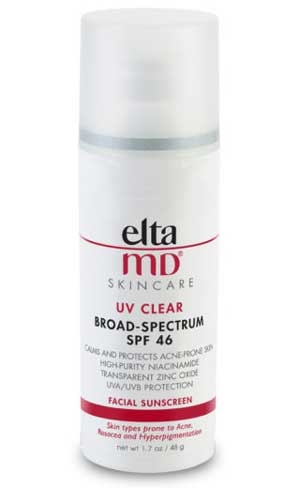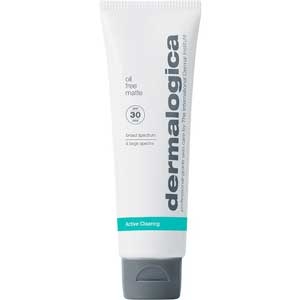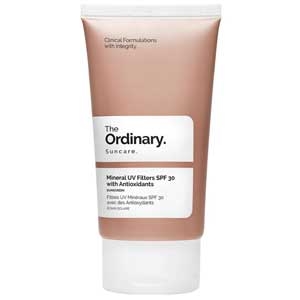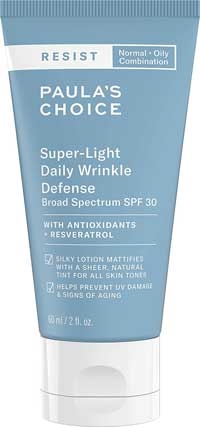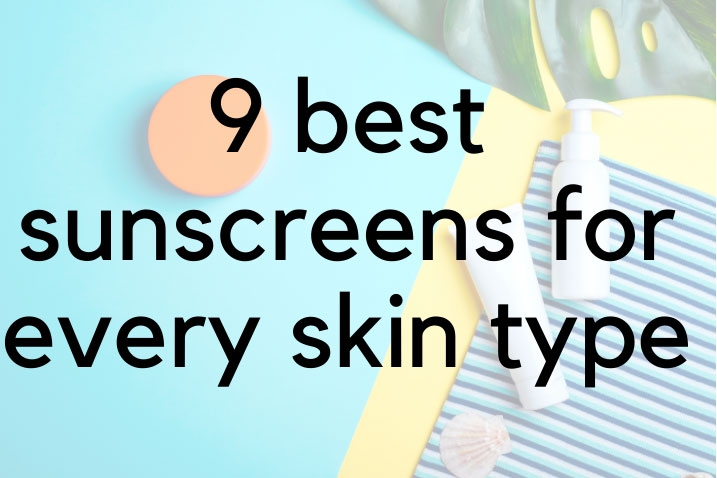
Popping here to update this sunscreen guide since we’re close to summer. During this time of year, when we’re spending more time outdoors, it’s actually even more important to protect your skin with sunscreen.
The daily sunscreen with SPF 30 you’ve been applying once in the morning won’t be enough if you’re going to be spending a day at the beach or the pool.
My personal experience not wearing sunscreen
Confession time. I actually did NOT like to wear sunscreen for the longest time and there’s a reason why.
I’ve been playing tennis since I was in high school…it’s a sport I love to play, even today.
During my junior year in high school, I got our team photos for the yearbook back and was completely mortified – I had a horrible white cast on my face!! It was the sunscreen my mom had been forcing me to wear.
Well, as you can imagine it was quite embarassing and I vowed that was the last time I ever wore sunscreen.
Why sunscreen is important
Well, fast forward to college, when I started noticing dark spots on my face. I was barely 20! I didn’t understand that sun damage can cause premature signs of aging such as sun spots, wrinkles, and fine lines.
Once you get these, it’s very difficult to reverse, so prevention is definitely key. I had to go to a dermatologist once a year to get laser treatment for dark spots. I now wear sunscreen religiously everyday. It still doesn’t prevent 100% of sun exposure, though – you have to be very proactive in reapplying sunscreen.
This is why I cringe SO HARD when I see people tanning without sunscreen, or even worse, going to tanning bed salons.
Save a pin for later

Quick 411 on sunscreens
I have tried many different sunscreens and am glad to report that they have come a long way since my high school days. There are many kinds of sunscreen now that will provide the protection without the awkward white cast.
But I get it – not everyone wants to spend hours and hours researching sunscreens and they’re so complicated! SPF, UVA, UVB, Broad Spectrum, PA+++, ingredients, brands – how do I pick the best one for me?!
Let’s break down the difference, and help choose the right sunscreen for your skin type and concern.
UVA and UVB Rays
First, to understand why not wearing sunscreen can lead to fine lines and sun spots, we have to understand that the sun emits two types of rays, both of which are harmful for your skin, but in different ways.
The two types of rays are UVA and UVB – while UVB is the more obvious culprit that causes sunburns. UVA causes slower damage that accumulates over time. You may not see the results as fast as a sunburn, but its effects are just as bad: UVA rays cause wrinkles and other signs of premature aging. It might sound complicated, so just remember:
- A for Aging
- B for Burning
It’s important to note that just like zombie apocalypses, when it comes to harmful rays, you are not safe indoors or on cloudy days. Which is why you gotta wear sunscreen daily.
What does this mean? When looking at sunscreen labels, look for the words “Broad Spectrum” – this means it protects against both UVA and UVB rays.
SPF: Sun Protection Factor
Here’s something you might be more familiar with: SPF. SPF stands for Sun Protection Factor, and it’s a unit of measurement used to indicate how effectively it protects against UVB rays, which causes sunburns.
Quick tip: Did you know that while SPF can tell you how it protects against sunburns, it does not indicate how it protects against wrinkles?
PA Ratings: More common in Asia
In order to see how effectively a sunscreen protects against UVA rays, which remember, causes aging, you have to look at the PA rating, which is not show on sunscreens sold here in the U.S. but is common and prevalent on Asian sunscreens.
If you shop for Asian sunscreens, you will notice that almost all of them will indicate the PA rating, which is measured in the form of plus signs. The more plus signs the sunscreen has, the higher the protection against UVA rays.
Tip: Just because a sunscreen doesn’t indicate the PA rating, doesn’t mean it doesn’t protect against UVA rays, it just isn’t a popular rating that US consumers are familiar with or look for, which is why brands don’t include it in the labels.
How to choose right SPF and PA
A good rule of thumb when looking for SPF is based on how much exposure you will have to the sun and the risk you’re in for getting sunburned.
- Work mostly indoors: and are looking for an everyday sunscreen, SPF 30 is sufficient.
- Work mostly outdoors: Or you’re spending a day hiking, at the pool or at the beach, then I recommend an SPF of at least 50, with frequent reapplication – at least once every 2-3 hours.
If you are shopping for Asian sunscreens and want to know what PA rating to choose, I always go for the maximum protection.
Pick up a PA+++ to not take any chances with wrinkles, spots, or other early signs of aging.
Physical vs. Chemical Sunscreens
Now that we’ve gotten that out of the way, let’s talk about two main types of sunscreens.
Physical sunscreens (aka sunblock)
Physical sunscreens contain zinc oxide and titanium dioxide and are sometimes referred to as mineral sunscreens or sunblock. These sunscreens work like a mirror to deflect the sun’s rays.
Pros:
- They are less likely to clog pores and cause allergy issues
- Starts working the second you put it on
Cons:
- Because the minerals naturally occur as a white powder, these sunscreens are generally associated with the white cast that most people associate with sunscreens.
Example of white cast that some physical sunscreens can leave

Image credit: Dermalogica
The good news is, sunscreen science and technology has come a long way, and brands are introducing physical sunscreens that have significantly less white cast than before.
Dermalogica is an example of a brand whose new product, Invisible Physical Defense SPF 30 is a mineral sunscreen that is ultra-sheer.

Image credit: Dermalogica
Chemical Sunscreens
Chemical sunscreens work by absorbing the sun’s rays and transforming them into heat, which is then released from your skin. It’s not necessarily bad, but for people who don’t like the idea of chemicals in skincare might prefer to use physical sunscreens instead.
Pros:
- Absorbs readily into the skin, lighter formulas. Easy to find as it’s more prevalent than physical sunscreens
Cons:
- Higher chance to cause allergic reactions or irritate skin, since multiple ingredients have to be combined together to provide the broad spectrum protection we talked about earlier.
- Whereas physical sunscreens start to work the second you apply them, chemical sunscreens take time to activate after application. So another way to differentiate between physical and chemical sunscreens aside from reading the ingredients is to look at usage directions. If it says apply 20-30 minutes before sun exposure, it’s likely to be a chemical sunscreen.
Deciding between physical and chemical sunscreens really comes down to personal preference.
At the end of the day, I recommend choosing a formula that you will actually want to wear, because if you don’t like the formula, the chances of you using it will be slim. So choose a formula you like, and stick with it!
Best Sunscreens For Every Skin Type and Concern
Reminder: If you need help determining your skin type, check out this post first. It’s important to pick the right product for your skin’s unique needs.
Best Overall Sunscreen for Combination Skin
My personal favorite and the current everyday sunscreen I am using is the Elta MD UV Clear Broad Spectrum SPF 46. It’s a sunscreen that was recommended to me by my dermatologist.
In my opinion, it’s a great sunscreen for combination skin, doesn’t leave a white cast and is non-greasy and plays nice with other skin care products (no pilling, weird reaction).
Runner Up: La Roche-Posay’s ULTRA LIGHT SUNSCREEN FLUID is what I use when I am outdoors playing tennis or by the pool because of the extra high SPF 60 protection.
It’s a multi-award winning facial sunscreen with advanced protection in a lightweight fluid. Even though it finishes off matte, when it applies it has a slightly greasy feel which is why I prefer Elta MD for everyday sunscreen.
Best Physical Sunscreen for Combination Skin

As mentioned above, Dermalogica just launched the new Invisible Physical Defense SPF 30 and it looks incredible. It’s a weightless invisible sunscreen that doesn’t leave behind any white cast.
Best Lightweight Sunscreen with Matte finish for Oily Skin
Dermalogica’s Oil-free Matte SPF 30 is a great choice for people with oily type skin. It’s a ultra-sheer formula with niacinamide and biotin, so it’s also ideal if you suffer occasional breakouts.
Best Physical Sunscreens for Oily Skin
The Ordinary Mineral Sunscreen SPF 30 has a matte finish that’s a great choice for oily skin types. Bonus: for a sunscreen, it’s super affordable, too!
Related: For other great The Ordinary products specifically for Oily Skin types, check out this post!
Best Sunscreen for Oily Skin with Anti-Aging Concerns
Paula’s Choice Resist Super-Light Wrinkle Defense SPF 30 is an excellent sunscreen that does double duty – smoothes over pores and fights against premature aging.
Paula’s Choice Skin Balancing Ultra-Sheer Daily Defense SPF 30 is another great choice. It’s loaded with potent antioxidants proven to help your skin look and act younger while minimizing oil and smoothing dryness. Your skin will feel soft and have a fresh matte finish.
Best Sunscreens for Dry Skin with Anti-Aging Concerns
Dermalogica’s Dynamic Skin Recovery SPF 50 Broad Spectrum moisturizer helps combat the appearance of aging skin. It’s a medium-weight sunscreen that is very emollient (moisturizing) with high SPF 50 protection.
La Roche Posay Anthelios AOX Daily Antioxidant Serum with Sunscreen SPF 50 is an anti-aging treatment and sunscreen in one. This concentrated formula helps to protect against sun exposure and improve the appearance of fine lines, dark spots, and skin texture.
Related articles you may like:
If you struggle with dark spots from too much sun exposure, check out this post to learn how to shop for products from a budget-friendly, effective skincare line called The Ordinary that target pigmentation concerns.
If you have oily skin, I’ve compiled a list of 19 BEST Foundations (rated by 5 beauty editors) for oily skin types. There are best options for acne concerns, longest lasting, and drugstore picks.
Wondering what products are best for people with dry skin? Check out this post.

